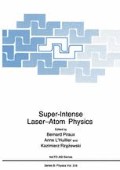Abstract
In recent years there have been very significant advances in short pulse, high intensity laser technology. Lasers with pulse lengths of 0.1–1 ps and wavelengths from 0.2–1 μm can be focused to produce intensities from 1012 to above 1018 W/cm2. One major use of these systems has been for studies of the response of atoms and molecules to such intense, well characterized electromagnetic fields. Because these pulses are very short, neutral atoms can survive to experience intensities where theoretical treatments based on the traditional perturbation expansion of the wave function in terms of the field-free states will fail completely to describe the dynamics of the system. An explicit, non-perturbative time-dependent calculation is one approach which can represent these strong field effects.
Access this chapter
Tax calculation will be finalised at checkout
Purchases are for personal use only
Preview
Unable to display preview. Download preview PDF.
References
G. Petit, P. Agostini and F. Yergeau, J. Opt. Soc. Am. B 4:765 (1987).
K. J. Sehafer and K. C. Kulander, Phys. Rev. A 42:5794 (1990);
K. J. Sehafer, Comp. Phvs. Comm. 63:427 (1991).
J. Macklin, J. D. Kmetec and C. L. Gordon III, Phys. Rev. Lett. 70:766 (1993);
A. L’Huillier and P. Balcou, Phys. Rev. Lett. 70:774 (1993).
A. L’Huillier, K. J. Sehafer and K. C. Kulander, J. Phvs. B 24:3315 (1991).
K. C. Kulander, K. J. Sehafer and J. L. Krause, Time-dependent studies of multiphoton processes, in: “Atoms in Intense Radiation Fields,” M. Gavrila, ed. (Advances in Atomic, Molecular and Optical Physics, Supplement 1) Academic Press, New York (1992)
K. C. Kulander and T. N. Rescigno, Comp. Phys. Comm. 63:523 (1991).
K. C. Kulander, J. L. Krause, K. J. Sehafer, S. W. Allendorf, J. K. Crane, K. S. Budil and M. D. Perry, in Time Dependent Quantum Molecular Dynamics: Experiment and Theory. J. Broekhove and L. Lathouwers, Eds. (Plenum, New York, 1992).
S. W. Allendorf, J. K. Crane, K. S. Budil and M. D. Perry, to be published.
K. C. Kulander, Phys. Rev. A 38:778 (1988).
K. C. Kulander and B. W. Shore, J. Opt. Soc. B 7:502 (1990).
J. L. Krause, K. J. Schafer and K. C. Kulander, Phys. Rev. A 45:4998 (1992).
K. Burnett, V. C. Reed, J. Cooper and P. L. Knight, Phys. Rev. A 45:3347 (1992).
K. J. Sehafer, B. Yang, L. F. DiMauro and K. C. Kulander, Phys. Rev. Lett. 70:xxxx (1993).
A. L’Huillier, P. Balcou, C. Candel, K. J. Sehafer and K. C. Kulander, Phys. Rev. A 46:2778 (1992).
B. W. Shore and K. C. Kulander, J. Mod. Opt. 36:857 (1989).
P. B. Corkum, N. H. Burnett and F. Brunei, Phys. Rev. Lett. 62:1259 (1989).
J. Javanainen, Q. Su and J. H. Eberly, Phys. Rev. A 38:3430 (1988). The parameter in the denominator of this potential is set to 2.0 to obtain a binding energy of 13.6 eV.
H. A. Bethe and E. E. Salpeter. “Quantum Mechanics of One- and Two-Electron Atoms,” Plenum, New York (1977).
R. A. Smith, J. W. G. Tisch, M. S. N. Ciarrocca, S. Augst and M. H. R. Hutchinson, this workshop.
J. Larsson, A. Persson, S.Svanberg, C.-G. Wahlström, P. Balcou and A. L’Huillier, this workshop.
J. L. Krause, K. J. Sehafer and K. C. Kulander, Phys. Rev. Lett. 68:3535 (1992).
B. Wolff, H. Rottke, D. Feldmann and K. H. Welge, Z. Phys. D 10:35 (1988).
We note that Paul Corkum has independently extended his quasi-static model (Ref. 16) also along these lines to consider both harmonic generation and impact ionization of the ion core by returning electrons.
Author information
Authors and Affiliations
Editor information
Editors and Affiliations
Rights and permissions
Copyright information
© 1993 Plenum Press, New York
About this chapter
Cite this chapter
Kulander, K.C., Schafer, K.J., Krause, J.L. (1993). Dynamics of Short-Pulse Excitation, Ionization and Harmonic Conversion. In: Piraux, B., L’Huillier, A., Rzążewski, K. (eds) Super-Intense Laser-Atom Physics. NATO ASI Series, vol 316. Springer, Boston, MA. https://doi.org/10.1007/978-1-4615-7963-2_10
Download citation
DOI: https://doi.org/10.1007/978-1-4615-7963-2_10
Publisher Name: Springer, Boston, MA
Print ISBN: 978-1-4615-7965-6
Online ISBN: 978-1-4615-7963-2
eBook Packages: Springer Book Archive

